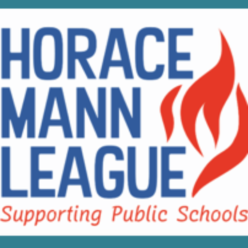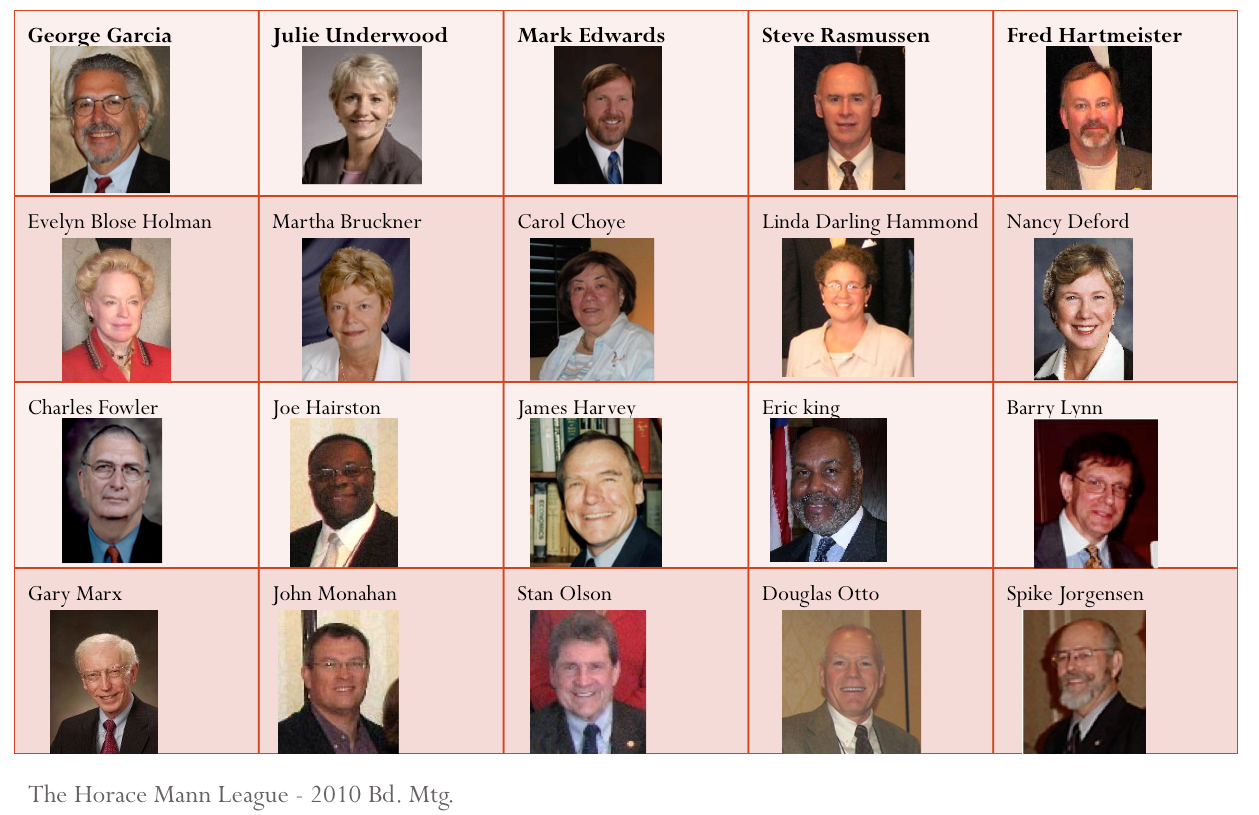Horace Mann League, Minutes for June 27, 2010.
The Horace Mann League of the USA
Summer Board Meeting, June 226-27, 2010, Chicago Marriott O’Hair Hotel
Saturday, June 26, 2010
Strategic Planning Session
Notes from the Strategic Planning Session (see below)
The Horace Mann League of the USA
Business Meeting, Sunday, June 27, 2010, Chicago Marriott O’Hare Hotel
Meeting called to order at 8:00 a.m. on Sunday, June 27, 2010.
Members Present: George Garcia, Julie Underwood, Steve Rasmassen, John Monahan, Stan Olson, Gary Marx, Martha Bruckner, Nancy DeFord, Joe Hairston, Charles Fowler, Eric King, Fred Hartimeister, Stan Olson, and Jack McKay
Board Actions:
1. Update on publication of book, “Assuring our Public Education Heritage.” Jack McKay will follow-up with a contact with Wiley Books (Kate Gagum) .
2. Membership Report:
Discussed current membership and trends
Reviewed recruitment strategies
Agreed to continue with each board member nominating 20 potential members each year
Jack McKay will follow-up with recruitment packets (brochure, return envelope, letter for signature, stamped and addressed envelope )for each person nominated
Officers and directors encouraged to add personal note and follow-up phone call.
3. Revenue and Expenditure Update: A review of the year-to-date revenues and expenditures.
4. Corporate Partners: Reviewed status of corporate sponsors: Apple Computer, Discovery Education, Promethean Boards, Scantron K-12, and Spectrum K-12.
5. Update on print sales and book sales. Major book sales to Plano ISD, Issaquah School District and Baltimore Co. Public Schools.
5. Membership Dues: Following a discussion of the positive and negative impact of implementing a tiered dues structure, the following was approved:
Professional Level Membership: $75 annual
Retiree Level Membership: $50.00 annual
Student Level Membership: $25.00 annual
Moved by Charles Fowler, seconded by Stan Olson to adopt the tiered dues structure. Passed
4. Services to Members: It was suggested that two services, currently used the by the Executive Director be made available to the officers and directors, with the possibility of being a benefit to the members. Jack McKay will check of the legality of others using the two services.
—— Survey Monkey is an online survey application http://www.surveymonkey.com/
— Elluminate.com provides up to 25 participants in audio and video conferencing. http://www.learncentral.org/user/vroomreg
5. Annual Meeting Speaker: Agreed that there be one featured speaker at the annual luncheon.
6. Nominations Committee Report:
Vice President: Dr. Joe Hairston, Supt. of School, Baltimore County Public Schools
Director: Dr. Brent Clark, Executive Director, Illinois Association of School Administrators.
Moved by Steve Rasmussen, seconded by Gary Marx, to approve the Nominations Committee Report. Passed
7. Annual Awards: Not official.
The “Outstanding Friend of Public Education” Diane Ravitch, Education advocate, researcher and author
The “Outstanding Friend of Public Educaiton” Bright Futures, Ken Bird, Director
Motion by Charles Fowler, seconded by Steve Rasmussen to approve the award nominations. Passed
8. Meeting adjourned at 11:45 a.m.
——————————————————————————-
Strategic Planning Notes
The Horace Mann League
Strategic Planning Session
Saturday, June 26, 2010, Chicago Marriott O’Hare Hotel
George Garcia, Julie Underwood, Steve Rasmassen, John Monahan, Stan Olson, Gary Marx, Martha Bruckner, Nancy DeFord, Joe Hairston, Charles Fowler, Eric King, Fred Hartimeister, Stan Olson, and Jack McKay
Facilitator: Ken Bird and Sharlene Karbowski
Purpose of the Horace Mann League
Strengths and Weaknesses
Objectives
Membership:
HML Index
Coalition of People and Organizations:
Purpose of the Horace Mann League
In the tradition of Horace Mann, we believe public education is the cornerstone of our democracy. To ensure the continued viability of public education in an ever-changing world, the Horace Mann League dedicates itself to:
- Advocating for a progressive, dynamic, responsive, strong system of public education that is free, classless, non-sectarian, and open to all children,
- Advocating for appropriate financial support at the local, state, and federal levels,
- Opposing the diversion of public funds to non-public education,
- Defending the Constitutional protection of separation of church and state as it relates to public education,
- Developing a network of individuals who actively support the ideals of Horace Mann,
- Identifying and confronting issues that are detrimental to public education,
- Representing the value and reality of pubic education to executive, legislative, and judicial bodies; and,
- Recruiting and recognizing those who advance public education.
Strengths and Weaknesses
| Strengths | Weaknesses |
| Composed of Influential leaders and thinkers | Meeting-based organization and meetings as a form of influence are diminished. |
| Our central purpose is more important today than ever. | Membership is not reflective of emerging field. |
| Organization represents a noble cause and is based on the work on a person who was a radical leader. | Lack of Alignment in incorporating behaviors that support public education (not positioning ourselves to contradict the billionaire clubs or business community) |
| To passive in reinforcing or modeling our purpose. | |
| We need to expand the base of membership in part by admitting all educators needs to be regarded as leaders. Admit all educators are leaders. | |
| Our number of members is too low if we are really going to have an impact on the current day. | |
| Very admirable cause (high ground). | Have not identified activities we want to really be engaged in and would determine what our target audience would be. |
| We recognize educational leaders across the country. | Our minimum resources. |
| Our mission has been said in different ways, but a powerful idea. | We want to do more, but do not have resources to do, but how do we do more if we do not have money to do more . . . objectives limited by that. |
| Quality of membership of league as it is and recognition of members at National level. | Forces against us have risen over past 20 years and on defensive. |
| Executive Director. | Media coverage of public education has been negative. |
| How do we engage our members on our list? | |
| If we had more $$/resources/corporate sponsorship what would we do other than we do now to meet the purpose of the League. | |
| Identity Crisis (difference between and honorary (passive) organization and active organization) Do we need to clarify that we are an activist? | |
| Defending cannot be a substitute for initiating. | |
| Not politically active or more involved. | |
| Membership down overturning (863 last year, 1173 at peak, net loss in new membership). | |
| Quality, demographics of memberships. | |
| Retiring Superintendents. | |
| Racing to recruit new members. | |
| (Younger Generation) Not as many joiners. | |
| More joining ASCD. | |
| So attached to one organization, sensitive to one organization than many | |
| Use technology and use of social media in effective way. |
Objectives
Membership:
(George Garcia, Martha Bruckner, Eric King, John Monahan, and Fred Hartmeister)
- Rebuild and maintain active memberships to a minimum of 1200 by 2012.
- Study membership trends (how long do they stay?)
- Discuss broadening membership categories.
- Decide amount of dues, differentiated dues structure that would attract & keep members.
- How do we retain members?
- Determine “what do you get for membership?”
- Determine alternate ways to reach out to alternate membership types.
- Restructure Membership (supporting membership, teachers, principals, parents, e-memberships, etc.)
- Stay in touch with potential member needs to give them a reason to become an HML member to fill a vacuum or need.
- What does HML do? Annual meeting,
- Communication Plan (definable, attractive, understandable)
- Clarify expectations
- Tap into people’s passions dedicating to promoting public education
- Why people join organizations – Dale Paulson’s work on allegiance . . .
- Survey/assess current, past, and potential members regarding interests and needs for HML.
- Define involvement of current and upcoming administrators (technology social networking/communication.)
- Rebuild and maintain active memberships to a minimum of 1200 by 2012.
HML Index
(Julie Underwood, Steve Rasmussen, Charles Fowler, and Gary Marx)
- By 2012, the HML will develop, implement, and publicize the HML index measuring the positive influence of public education (democracy, etc.)
- Annually, conduct a survey of “Factors contributing to high-quality public education.”
- Include hard, measured data about factors that impact public education
- Communication Plan for using the index
- Index to show ways public schools supporting society
- Do constant and each year have variable
- Possible Gallup partnership
- Measure support for public education (economics to health of students)
- Identify and financially support outside person doing that type of research in collaboration with the university (leverage support)
Coalition of People and Organizations:
(Nancy DeFord, Joe Hairston, Stan Olson, and Jack McKay)
Convene and sustain a coalition of people and organizations with the same, shared purpose of supporting public education.
Single issue, multiple groups, electronic
Seek alliance with 1-3 other organizations to support purpose in a period of 5 years.
AASA, PDK, ASCD to carry out HML support, e.g. campaign on Public education in America
HML does not represent position, but can lend itself to bringing people together, e.g. Facebook, theme to unite for critical mass (Learning First Alliance shared projects)
Why?
Visibility of the concern about for public education, access to others interested in public schools, access to other networks of educators, influencing or impacting mutual concerns, modeling the purpose of public education, sharing information, increasing membership, mounting initiatives on behalf of public information, networking with mutual links, matrix of organizations with mutual concerns, identify shared common goals,
Common concerns:
Prepared students, high achieving schools, unified policy position of issues of mutual concern, respect and promote for the voice of the practitioners, public schools should be free, non-sectarian, and classless.
Identify the other organization’s purpose and then identify the commonness of the two.
How?
- Identifying like organizations, meeting with organizational representatives and directors, packet of information about the coalition/network, develop list of organizations/associations that share beliefs about the value of public schools and the Horace Mann League, ask other organizational leaders about identifying other organizations (large and small) supporting public education, prepared presentation with proposal, start with survey HML board members for current affiliations.
- Face to face presentations, Chat room, list serves, face-book, social media, websites,
When: Goal of at least two organizations affiliations per year.
Two months: draft packet and HML Bd. Survey of organizations completed
Six months: Schedule meetings with at least two organizations
2 months: Complete meetings and have agreements with two other organizations
Affiliation presentation: Signed agreement/certificate, letter of agreement, HM framed print, electronic network,
Who: Joe, Nancy, Stan, Jack, and other board members as appropriate


9,409 thoughts on “2010 Summer Bd. Mtg. Chicago”
Comments are closed.